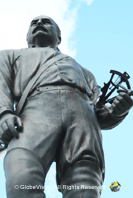
Alexander Forrest was born on the 22nd of September 1849 at Picton near Bunbury, Western Australia. The local lad was educated at a public school in Bunbury before later attending the Bishop Hale School (now known as the Cloisters) in Perth.
John Forrest, Alexander’s older brother (later to become the first Premier of Western Australia), began a career in surveying and it wasn’t long before Alexander was following in his footsteps. Whilst under contract by the Government Survey Department, John appointed his brother second-in-command and the two would often partake in expeditions together.
During the 1870s and 1880s, Alexander spent much of his time exploring areas of Western Australia. Alexander explored and mapped much of the State’s Northwest, including the Pilbara and the Kimberley regions.
In 1870, one of the first expeditions Alexander undertook (with his brother) was to travel the south-west of the continent in search of good pastoral lands. The journey led them to Adelaide.
In 1874, they were sent on an expedition, this time to explore and survey areas north of the State. With a small group of men, they left Perth and traveled first to Geraldton and then north-east to Murchinson River. On their way they did discover some ideal pastoral lands which had an abundance of water and named it Weld Springs after the Governor of Western Australia. They also named over 40 topographical features. On this journey, they reached the Overland Telegraph line, Chambers Pillar and Adelaide. This would be John Forrest’s final expedition.
In 1879 at the age of thirty, Alexander Forrest led his own expedition from Roebourne in the State’s north, up the coast to before venturing inland to an area now known as the Kimberleys. He named the region in honour of the 1st Earl of Kimberley (John Wodehouse) who was Secretary of the State for the Colonies. On this expedition, he would also name the Oscar, Napier and King Leopold Range and discover the Ord River. The expedition lasted nearly a year and resulted in the discovery of good, well-watered land suitable for cattle farming.
Following Alexander’s glowing reviews, Patrick Durack became the first settler of the region, establishing several cattle ranches. Patrick would undertake one of the most adventurous journeys in Australia’s pioneer history by droving his large herd of cattle and horses from Queensland to the pastoral lands of the Kimberley, in Western Australia’s far north.
Alexander ever the entrepreneur also became a land agent for the Kimberley area and was instrumental in the leasing over 51 million acres (21 million hectares) during 1883.
Alexander took an interest in several pastoral stations in the State’s north, one being the Minderoo Station, on the Ashburton River in the Pilbara. Taking advantage of his knowledge of the area and his position, he became a successful investor. Not only did he purchase real estate, he invested in gold, newspapers, timber and cattle shipping.
In 1887, he become the first Member for Kimberley in the Western Australian Legislative Council and later Mayor of Perth.
During the early 1890’s Alexander and fellow investors Charles Crossland and George Leake purchased and then subdivided a large section of land in the Perth area. This land would later become the suburb of Peppermint Grove.
In 1901, Alexander Forrest passed away in Perth following a short illness. A statue of Alexander was created by Pietro Porcelli and erected on the corner of Barrack Street and St Georges Terrace.
